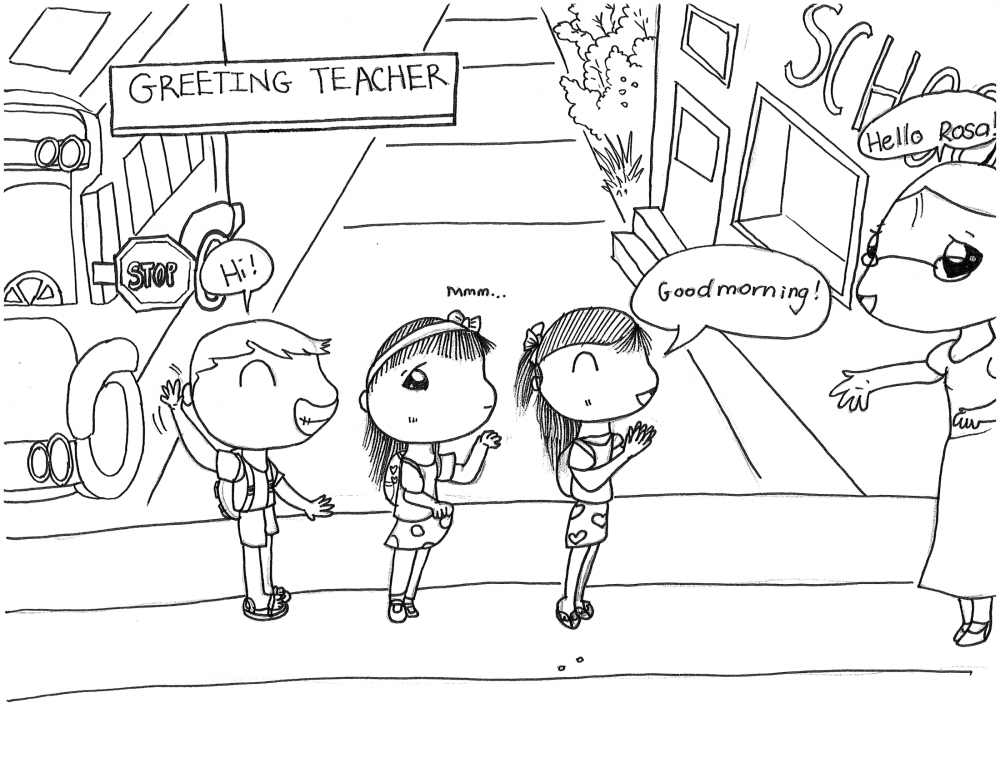聪明的艾米 SMart Amy
聪明的艾米 SMart Amy 是献给选择性缄默的儿童, 家长,老师和朋友。 展示如何在日常生活的交流和沟通中帮助选择性缄默儿童。内容包含特定的场景,活动和策略,加上有趣的儿童卡通图画,教选择性缄默儿童如何以非言语的方式交流,并帮助家长和老师制定帮助计划。

- Who: Amy, classmates, teacher
- Location: Outside of the school building
- Environment: Busy, people are moving around and talking
- Worry Level: 3
- Purpose: Have Amy prepare to say hello to the teacher when she enters the building, or have her copy others
- What is happening: Amy walks into and out of school with her whisper buddy. A teacher is greeting students at the door, saying hello to everyone.
Strategy and Scene
- Get off the bus and greet the teacher
- Teacher should not directly address Amy first, but should say hello to other students first
Friend:
- Get off the bus with Amy and walk with her to the classroom,
- Talk to Amy in the hallway
Teacher:
“Amy, that’s a beautiful dress! Did you pick it out yourself?”
“Amy, can you count the number of students absent from class today?”
“Amy, can you help me pass out these papers?”
- Rehearse the greeting with the whisper buddy. Amy can repeat after her friend and say good morning。 If Amy is not able to repeat the friend’s greeting, she can wave or smile at the teacher.
Before getting on the bus and while on the bus, Amy can practice greetings with her whisper buddy.
- Whisper Buddy: Good Morning!
- Amy: Good Morning.
- Mrs.A: Good Morning, Amy!
- Amy: Good Morning.
Repetition
- Say good morning to Amy (and other students) every morning so Amy expects a greeting every morning. This will allow her to prepare a greeting in advance and increases the chances of her speaking.
After getting off the morning school bus, Amy stayed close to her whisper buddy Catherine, and they moved along with other students to get to the school doors. Every day, a new teacher was at the door to greet the students. The first challenge was the bus ride, and greeting the teacher at the door was another challenge Amy had to face each day. Amy had established a system for herself that was hard for her to violate: No Looking, No Interacting, No Speaking; to quickly escape was her go-to instinct. “Hello, Tom! Good Morning, Sam!” The teacher said hello to all the students one by one. Initially, Amy felt a bit uneasy and nervous while waiting in line. Catherine kept on chatting with Amy, which eased her nerves. When they came up to the teacher, Catherine waved to the teacher first. “Good morning!” “Good morning, Catherine!” The teacher said. Amy, though still a bit nervous, repeated the greeting following her friend, as they had rehearsed on the bus. The teacher looked at Amy and smiled. “Good morning, Amy! Wow, Amy, that’s a beautiful dress! Did you pick it out yourself?” Amy felt bashful, but the teacher seemed very friendly and she managed to speak: “Thank you! Yes, I picked it out myself.” Amy and Catherine proceeded into the classroom.
Strategy: The teacher should not directly address Amy first, but should say hello to other students first. Rehearse the greeting with the whisper buddy, whom Amy can repeat after. If Amy is not able to repeat the friend’s greeting, she can wave or smile at the teacher. Teachers can also use repetition and say good morning to Amy (and other students) every morning so Amy expects a greeting every morning. This will allow her to prepare a greeting in advance and increases the chances of her speaking.
作者俊华,艾米妈 。 如有需要,加微信:junwang08837,艾米妈邀你进 “选择性缄默症家长分享群”。
选择性缄默症包括语言恐 Speech Phobia,感知障碍 Sensory Disorder, 社交恐惧 Social Anxiety 。 关键词: 孩子为什么不说话,孩子在外面不说话,孩子不敢说话,和陌生人不说话,社交恐惧,孩子在幼儿园和学校不说话,害羞,敏感,胆子小,懦弱,怕生,内向,没自信,固执,不敢吃饭,不敢去厕所,不敢和小朋友玩,,在家讲话,出门不讲话。只和爸爸妈妈说话, 不敢参加集体活动。




